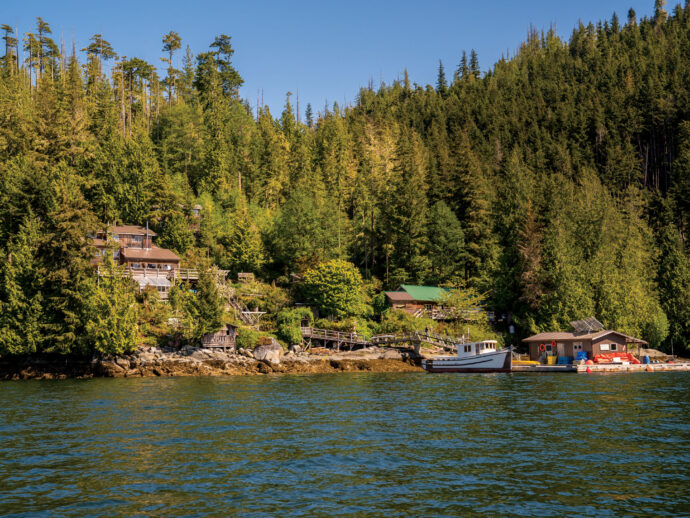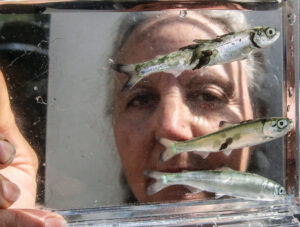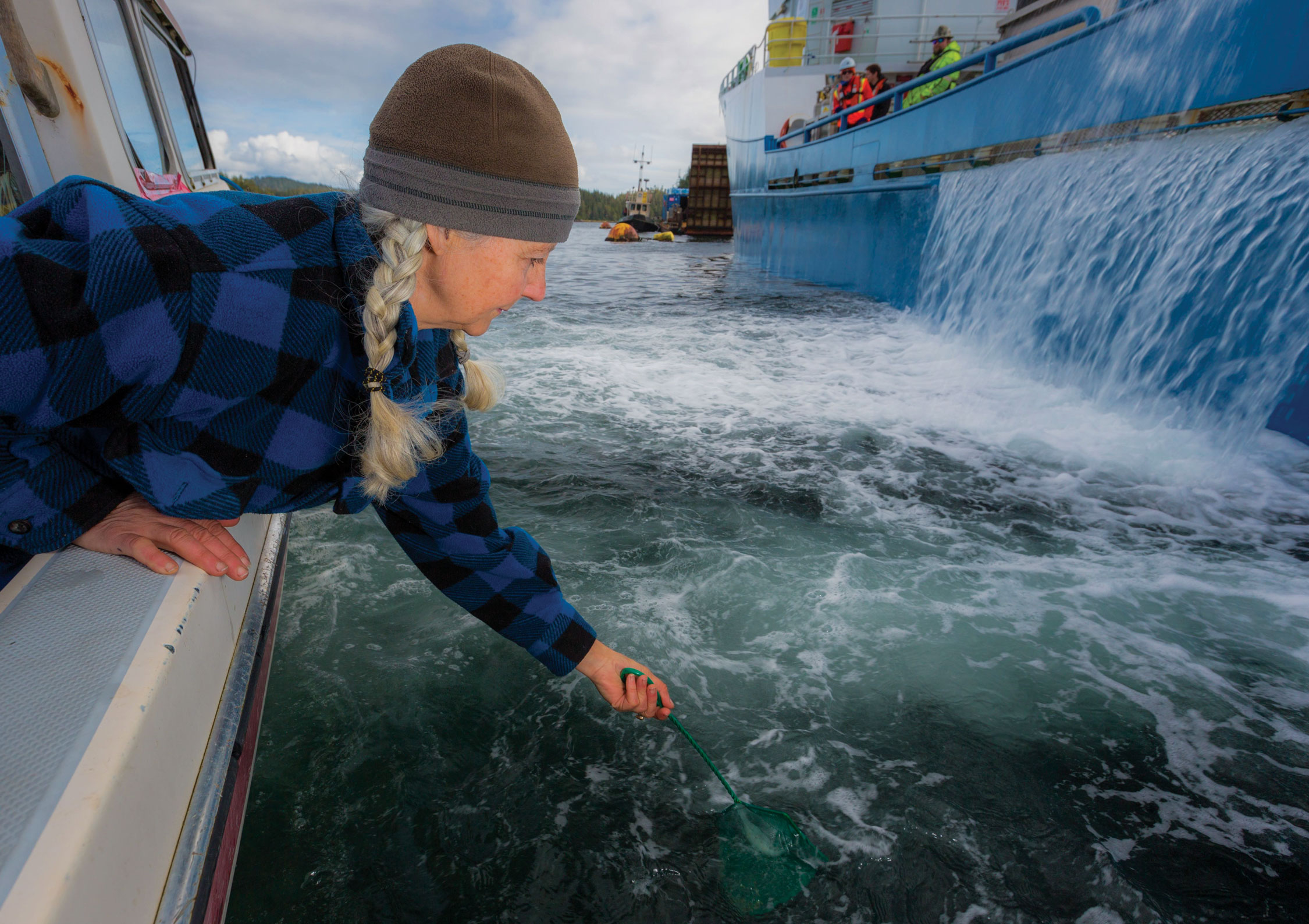
For more than four decades, Alexandra Morton has dedicated her work and her life to determine why the orcas and the wild salmon of the Broughton Archipelago are dying off—and to fight for those species’ very survival.
As a girl, Alexandra Morton read every single book by Jane Goodall, Dian Fossey, and other remarkable individuals who went into the wilderness to study wild animals, driven by a passion to understand and protect wildlife. The marine biologist pursued a similar path, moving to BC in 1979, after finishing university in California, to immerse herself in the world of orcas. >>
She settled in the remote village of Echo Bay, in the Broughton Archipelago. Then the whales she was studying began to leave and the wild salmon began to die off.
For nearly four decades, Morton has dedicated her work and her life to determine why—and to fight for those species’ very survival.
Open-net salmon farms
Morton’s research echoes findings of an international body of studies that suggests open-net salmon farms are to blame.
Viral diseases
In an interview with alive, Morton explains that dozens of fish farms, mostly owned by Norwegian companies, dot the stretch of the West Coast that she calls home. According to Morton, when salmon are contained in small spaces, disease spreads easily from one to the next, and nets can’t keep viruses, such as the piscine reovirus, from entering the ocean.
In fact, the greatest threat to wild salmon and other species from salmon farming are viruses, which are becoming increasingly virulent.
Sea lice
There are other serious problems with salmon farms, Morton says. The farms are breeding grounds for sea lice, which are parasites that feed on the flesh of fish. In nature, these organisms are benign and die off themselves. In salmon farms, however, they multiply and mutate. As young wild salmon swim to sea as part of their natural migration, the sea lice swarm them, eat them, and kill them.
Chemical warfare
To reduce lice counts, many fish farmers use drugs containing highly toxic chemicals, which also threaten crustaceans such as prawns. Salmon farming companies also use a bath treatment to kill lice. Workers place a tarp around the farm and pour chemicals in, and after the treatment has been delivered, they lift the tarps, and the material enters the ocean.
Morton has published dozens of science-based studies in some of the world’s most reputable fisheries-related journals about the effects of sea lice on wild salmon and other species.
She has also witnessed the consequences of salmon farming first-hand.
The wider effects
 “As scientists, we spend thousands of hours measuring the changes [in salmon populations], but I also see panicked mother bears racing up and down empty rivers with some kind of instinctual knowledge that she and her cubs are not going to survive the winter if they don’t get those fish,” Morton says.
“As scientists, we spend thousands of hours measuring the changes [in salmon populations], but I also see panicked mother bears racing up and down empty rivers with some kind of instinctual knowledge that she and her cubs are not going to survive the winter if they don’t get those fish,” Morton says.
“I see the orca with the big dents behind their heads; those are called peanut heads, because starvation removes the fat and you can see a dent between front of the head and the back. I see the young wild salmon vanishing.
“As a researcher studying whales, you have to know about salmon, because they’re the reason whales come and go,” she says. “I’m watching this place I love and understand die.”
A long-fought battle
As an activist, Morton’s efforts to get open-net salmon farms out of British Columbia are ongoing. She used to write letters to various levels of governments and salmon-farming companies, but after realizing those campaigns were going nowhere, she began augmenting pressure. She continued doing independent investigation, launched legal challenges, and made in-person visits to company headquarters overseas (see sidebar below).
Morton says the farms have been set up in places that are “hot spots” for wild salmon (as well as rock cod and prawns). Everywhere she turns, however, government and firm officials continue to shut down her requests to relocate or remove the farms altogether, quashing her reasoning by claiming there is “no evidence” to suggest the locations are significant places for wild fish and other marine animals.
Those rebuttals flummox and anger her. For further proof that salmon farms are irreversibly damaging to wildlife, Morton points to the fact that Washington State has banned Atlantic salmon farms entirely. (Although not native to the Pacific Ocean, Atlantic salmon are a major aquaculture species on the West Coast.)
A missed opportunity
Morton is not heartened by the BC provincial government’s announcement earlier this year that all coastal fish farms that want to renew or acquire a BC tenure will need approval from the Department of Fisheries and Oceans as well as an agreement with First Nations in whose territory they operate—but not until 2022. She had hoped that the farms would be ordered removed immediately.
“The news is devastating,” she says. “This will cause irreversible damage.
“I just don’t understand the failure to recognize the amazing production of wild fish on this coast and what a wealth that is,” she adds. “Every nation would love to have what we have left, but it’s going so fast.”
Hope from First Nations
Although she admits that, for the first time in her life, she’s experiencing stress and burnout from the monumental task of protecting wild salmon, Morton is heartened by the response from some local First Nations. Members of the Mamalilikulla, ‘Namgis, Dzawada’enuxw, and Kwikwasut’inuxw Haxwa’mis First Nations in the Broughton Archipelago have been actively protesting the presence of fish farms on their traditional territory.
“The First Nations are my hope,” she says. “Right now, I’m doing everything I can to support them. I’ve gone out and stood with them. They have rights that are being defiled.
“As a biologist, I feel that it’s absolutely imperative that we as a society learn to recognize the power cords that are keeping our world running, and the salmon is one of them,” Morton says.
“They go out in the ocean and they collect the energy that is created by the sun hitting the open Pacific, which stimulates plankton, which feeds salmon. They package that [energy] up and move it up into the watershed, then it pours down over the land feeding a hundred species and the trees that make the oxygen we breathe. So to kill off wild salmon, you might as well pull the power cord out of the side of your house.”

Timeline of a salmon hero
- 1993: Alexandra Morton stops studying whales and begins to scientifically measure the impact of salmon farms on the Broughton Archipelago.
- 1990s: Morton writes letters totalling 10,000 pages to governments, salmon farming companies, NGOs, and anyone else she could think of with this message: salmon farms must get off the wild salmon migration routes. The letters detail the impacts she’s recorded.
- 1998 to present: Morton writes or contributes to more than two dozen scientific papers related to fish farms, sea lice, viruses, or salmon population dynamics.
- 2005: Morton launches a private prosecution under section 55 of the Fishery (General) Regulations against the Cermaq-owned Burdwood fish farm in the Broughton Archipelago alleging it has been illegally releasing sea lice into fish habitat without a licence. The BC Ministry of Attorney General seizes control of the case and announces the prosecution has been stayed.
- 2008: Morton is part of a legal challenge that successfully argues it is the same water inside and outside of salmon farm pens. Therefore, farmed salmon are a “fishery.” Farmed salmon regulation is taken away from the province of BC and put back in the hands of the federal government.
- 2008: Morton applies to the federal government for permits and permission to evacuate young salmon before they encounter salmon farms and sea lice, take them safely past the farms, and place them back in the ocean: the so-called “medevac (salmon fry)” initiative.
- 2009: Morton brings forth a case in which charges are laid against Marine Harvest Canada Inc. under the federal Fisheries Act for illegal possession of wild juvenile salmon on its Orca Warrior ship. The following year, the Department of Justice assumes the case. In 2012, the company is fined $5,000 for failing to return wild fish to the ocean.
- 2009: Morton travels with First Nations chiefs to Norway to attend annual general meetings of salmon farming companies operating in BC.
- 2010: Morton and a small group of individuals start walking the 350 km trek to the provincial legislature in Victoria from the fishing village of Sointula to ask the government to stop allowing salmon farming. By the time they arrive, there are 5,000 people with them.
- 2011: Morton begins tracking fish farm viruses in wild BC salmon and in farmed salmon purchased in BC markets.
- 2013: Morton files a challenge in federal court along with Ecojustice challenging the illegal transfer of diseased fish in the ocean. Morton goes on to win the case in 2015; the minister of fisheries refuses to acknowledge the court decision.
- 2013: Morton co-publishes the first scientific paper on piscine reovirus outside of Norway.
- 2016: Morton co-publishes the first scientific paper on infectious salmon anemia virus in BC.
Morton sues the minister of fisheries again to uphold the law and test farm salmon for piscine reovirus prior to transfer into marine pens.



































